Beyond Smoke and Mirrors
Another George story begins with, “What you doing, boy?” as in 1965, aged 15, I crosscut a 4 by 8 with a brand new Canadian Disston (don’t get one) handsaw. The saw seemed constantly to drift out of square despite the squared-across lines I’d carefully placed on the rough-sawn faces of the wood and was supposedly trying to follow. Merlin looked at the cut ends and tutted away while tweaking my ear between his first finger knuckle and thumb and cursing me. We were building a cupola window as part of a replacement roof being installed on an old circular barn. These sections would be the cills for circular windows being built in sections. It actually didn’t matter to the whole that my end cuts weren’t square as these were just the rough cuts leading to mitres once machined and profiled on the spindle moulder by our machinist, Alan. Nonetheless, I squirmed inside at my own lack and the tweaking of my ear.
Back at my own bench with George, George said, “Come here, Boy!” with the emphasis on the word “boy” as Merlin had said it. We chuckled together for a moment. In the vise was a two-by-four, flat face up and overhanging the end of the bench. “Watch!” and he crosscut the section of wood and asked me to check it with the square. I did. It was dead square even though there were no lines to follow.
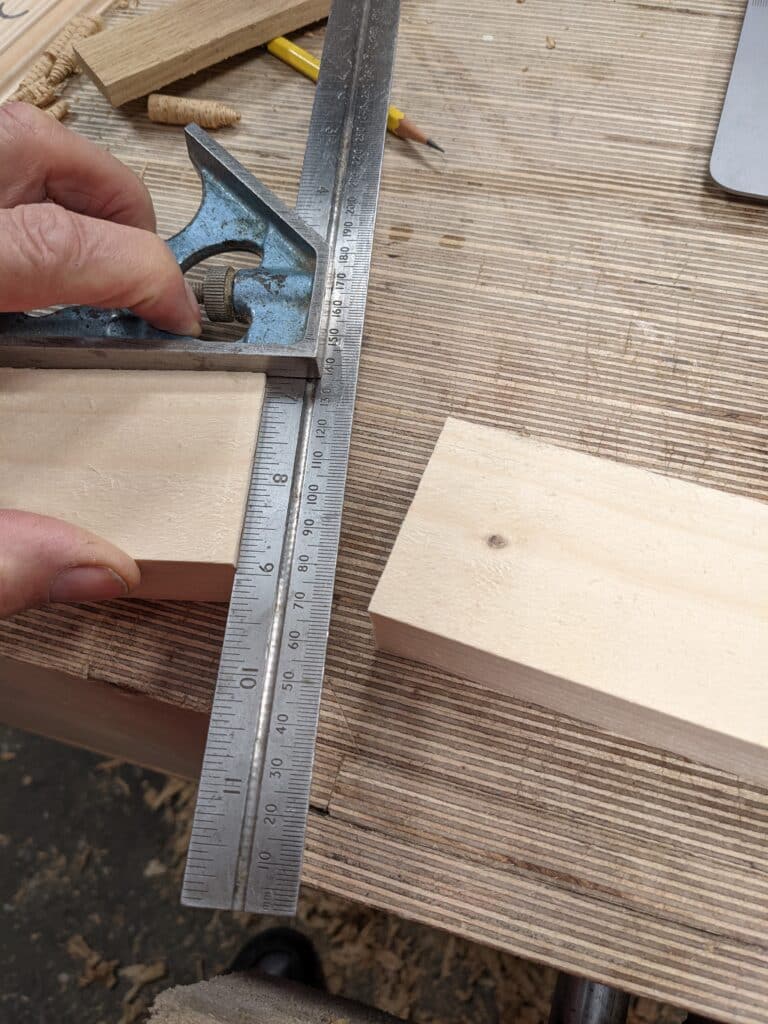
‘Wow!’ I said, ‘How did you do that?‘
“OK! Watch me to see if you see what I see.”
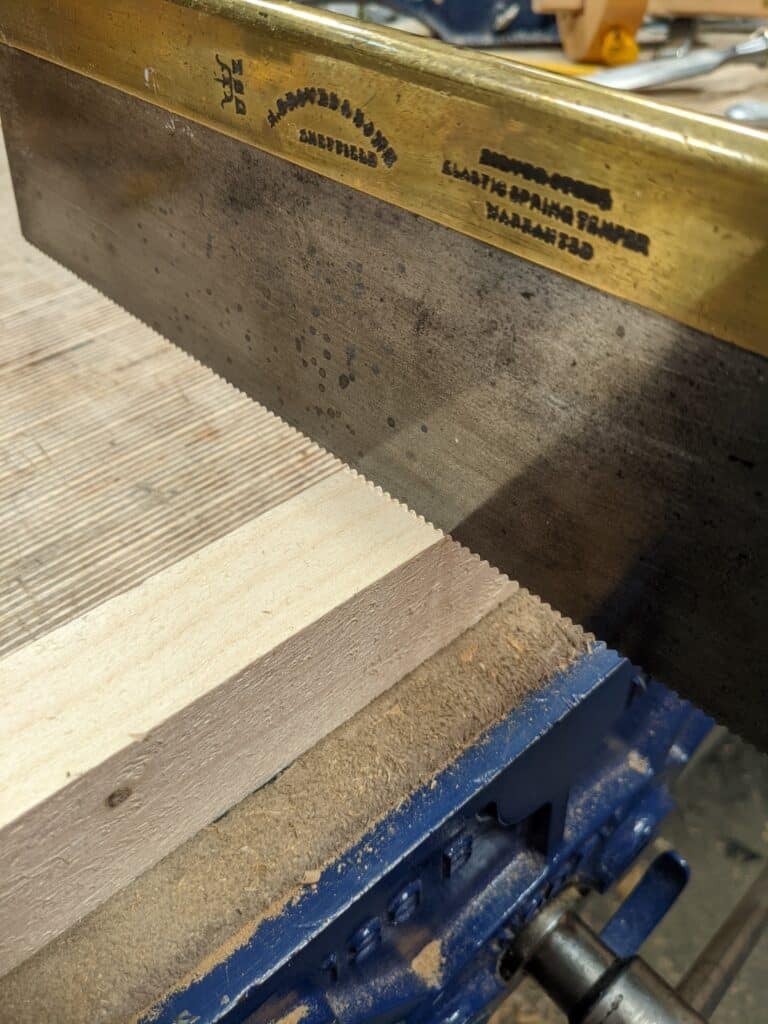
George placed the saw on the two-by edge and made a shallow, square-across cut first, entering the wood about a quarter of an inch.
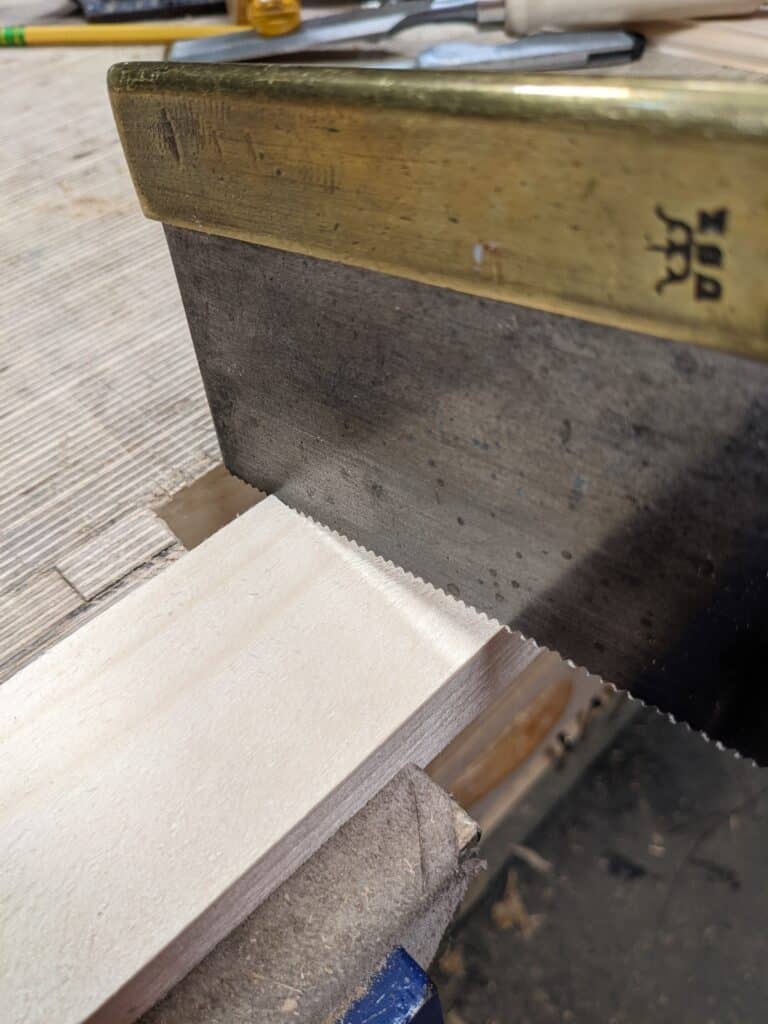
He then rotated the board in the vise to place the wider, flat face uppermost, placed his saw at the corner of the first cut, and lowered the saw square across and flat on the surface with two gentle strokes.
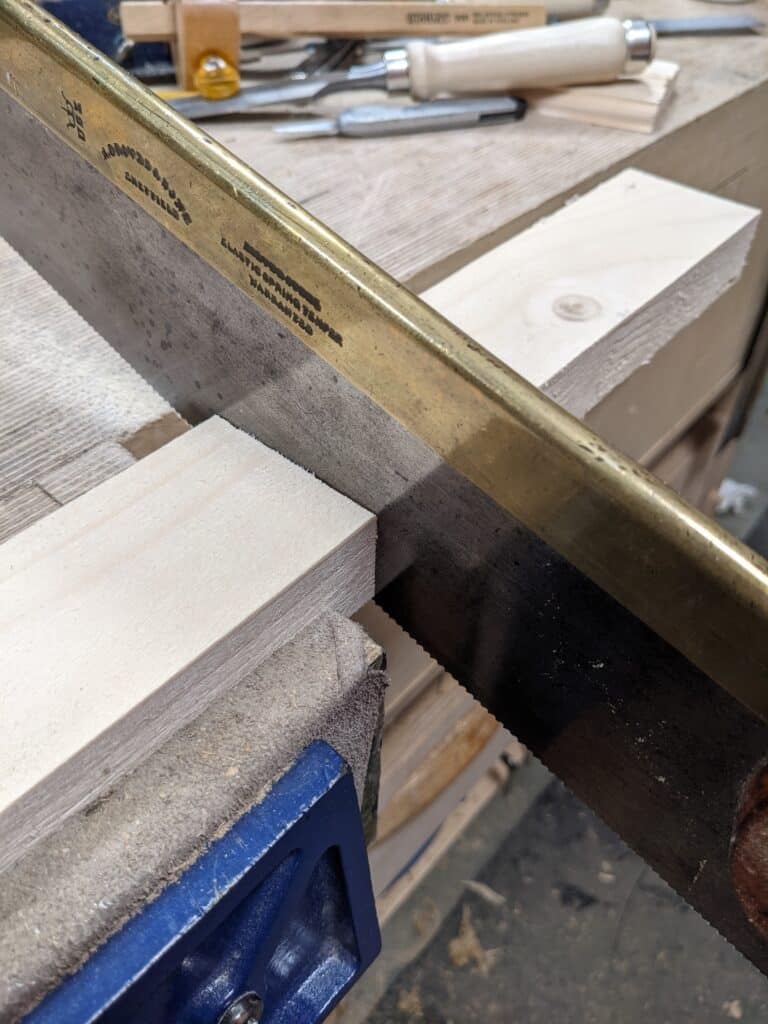
Subsequent cuts showed the saw going deeper and from my side of the bench, I saw him follow the first cut in the narrower 2″ face but then square and straight across the wide face too. He stopped and said, “What do you see?”
‘I see a square cut again, George. How did you do that/ How does Merl’ do it?’
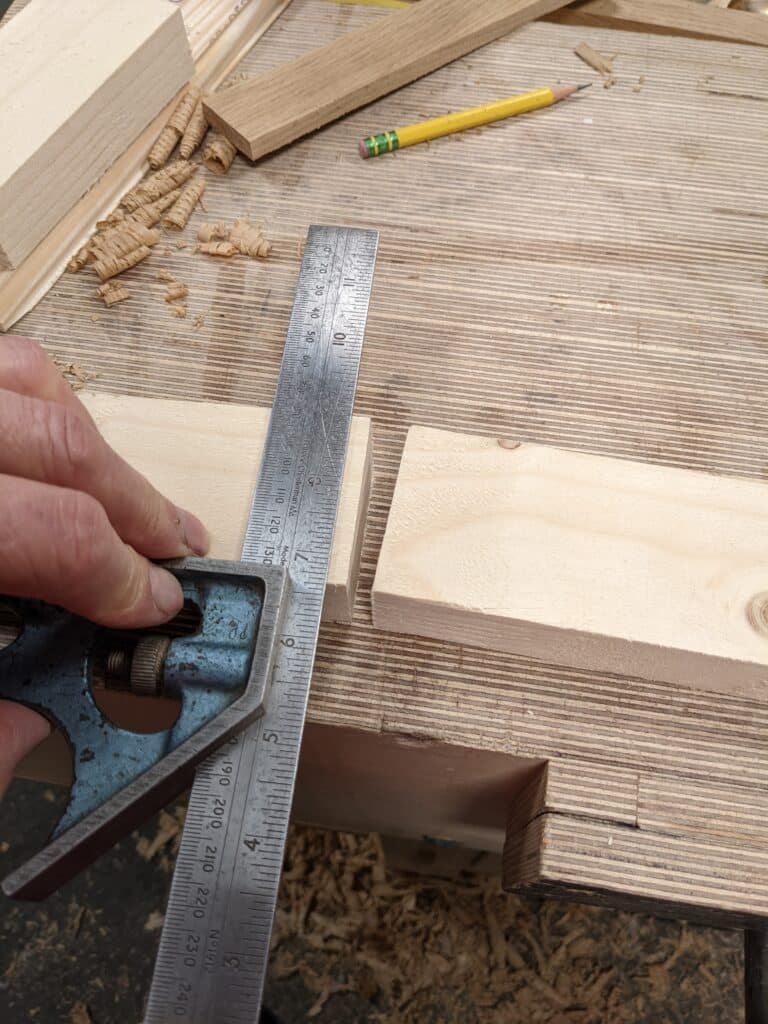
“Look again and keep looking until you can give me a correct answer,” Goerge said.
I looked and looked but could not see what George expected me to see. He took the saw out and moved the saw from one angle to another and back again. The question came again, “OK! Watch me do it more slowly.”
As I watched the saw swivel from left to right I caught a glimpse of something. Instead of seeing one piece of wood and one saw I saw two saws and two pieces of wood. There, right there, in the saw plate, I saw a perfect reflection of what was beneath the saw.
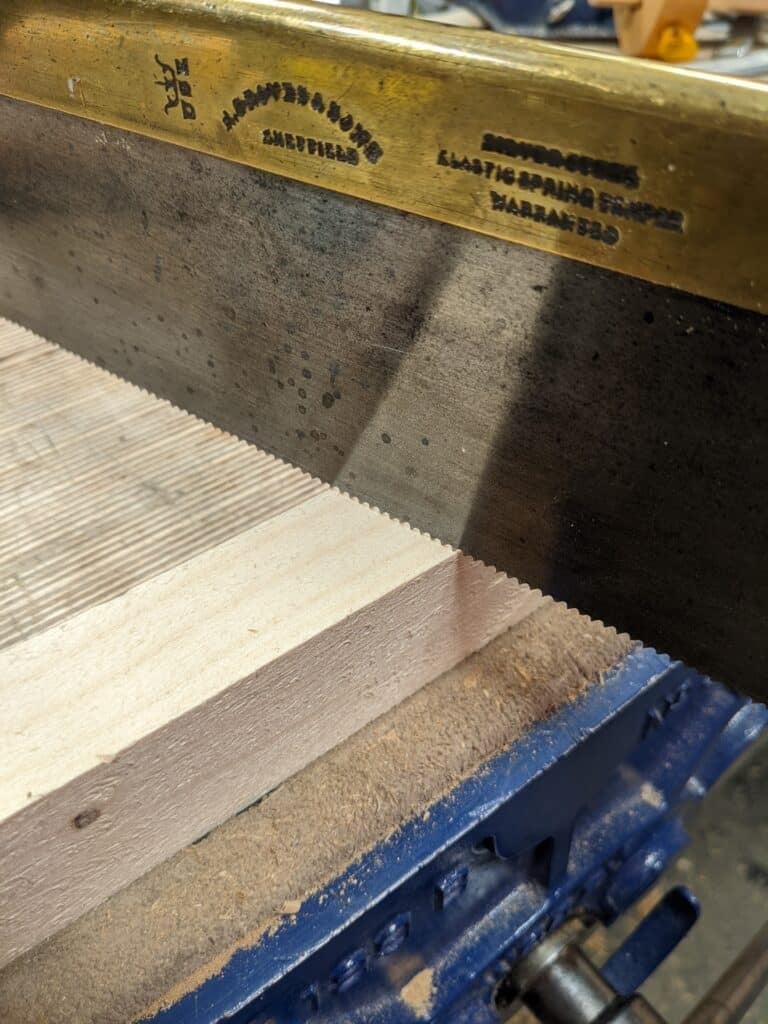
“OK, Paul, now watch the reflection.” George moved the saw slowly around on the surface of the wood. In the reflection, I saw the angle the saw was placed at on the surface. As he moved it, the angle the saw was at seemed to change along the long axis of the saw in the plate of the saw. It looked like a mitred section when he started. As the saw moved, `I saw the angle lessen until the reflection became ever straighter and when dead straight George stopped. That was it! Suddenly I got it; vertical and horizontal lines can reflect the straightness and the angle of a saw in its placement of the saw on the wood. Sighting it in gives you squareness of cut. All I needed now was a steady hand to my saw strokes.

My lesson wasn’t over either. George took the same two-by and placed the saw at an angle. He swiveled it from left to right and then started to cut at what seemed to be 45-degrees. He sliced through the wood with the handsaw and then took the two pieces, placed the mitres together, and offered his square to the inside corner. It was a dead ninety! When you see a reflection in the plate that looks like 45-degrees you will see a mitre form as a reflection like the corner of a picture frame and when it looks 90-degrees, start sawing.
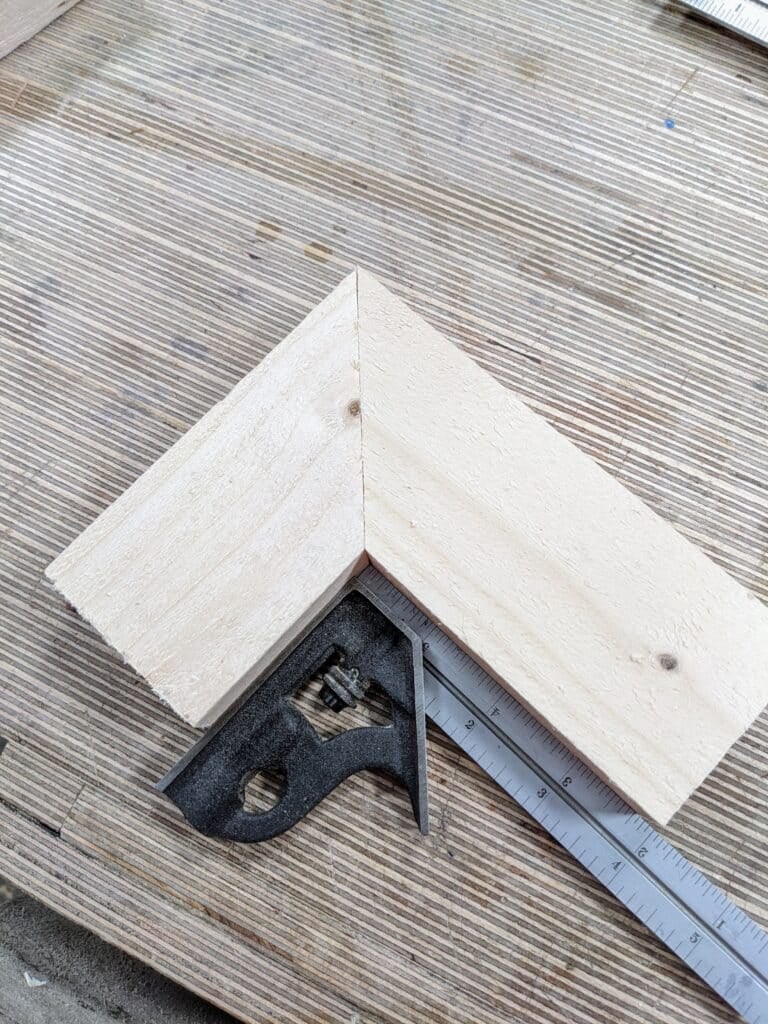
Life, geometry, maths, life again, is a whole new learning experience working at the bench with a man like George.


“… Canadian Disston (don’t get one) handsaw…”
Any specific reason Paul, since in my country that’s basically what’s available on the “antique” hand tool market – old Diston saws (varoiuse rip and panel saws).
I have a few I use for ripping stock, seems to work fine.
Regards
No problem with Henry Disston USA at all, just the Canadian takeover in the early 1960s when they never produced the same quality of saw. Too thick n clunky with no finesse. The Henry Disston USA were highly regarded wherever they found a home. I own some and they are very nice.
I bought an old signature series disston cross cut saw to compliment my dad’s old rip saw. I love the disston. I wasn’t aware of the Canadian versions. Thanks for the tip. I have come to rely on the reflection on the saw for my cuts. Great stuff as always, Paul. Thanks for the post.
My understanding is that they opened a Toronto operation in order to be able to market to the commonwealth without tariffs. I don’t mean to argue about it but I’m fond of mine because it’s served me so well. Over the years, I would pick up US made Disstons and other “nicer” saws but always reached for my dad’s 60s era Canadian Disston and ended up replacing it with another when the first’s teeth got down to the handle. It’s not a collector tool, so I didn’t feel bad taking a bit off the end to make it more suited to my bench work and I find the thicker blade makes it less likely to buckle when ripping long, thin pieces. I’ve even gotten used to the clunky handle. Safe holidays!
That brand “Disston” rang a bell. I ran out to the garage to look and, sure enough, the saw I was given as a (Canadian) boy was Disston. I wish I could blame my early failed but educational efforts on the saw…
“The heft and feel of a well-worn handle,
The sight of shavings that curl from the blade;
The logs in the woodpile, the sentiment of huge beams in an old-fashioned house;
The smell of fresh cut timber and the pungent fragrance of burning leaves;
The crackle of kindling and the hiss of burning logs.
Abundant to all the needs of man, how poor the world would be
Without wood.
(Everard Hinrichs)
Thanks for sharing. I successfully made the 2nd version of your workbench but stull struggle with a straight saw cut. Maybe this will help.
That’s magic, thanks Paul, & George!!
Thank you Paul,for all your words of wisdom,hints and tips.I can’t wait for Christmas Day,your book is wrapped and sitting beneath our Christmas tree,waving at me,teasingly.
Merry Christmas to you and yours Sir.
Never underestimate the Georges of this world! The knowledge he passed to you enables you to teach us so much.
I think we have much to thank George for.
May you and yours have a peaceful and safe Christmas, Paul.
And for sure, George’s are eternal opposite of karens!
I love the George stories, you were lucky to have trained under a kind and giving soul like George. Sounds like he was a great man to know.
Cheers
Charles
Excellent aricle – cutting square is a challenge (for me at least!).
Thanks Paul. Nothing like struggling through a problem and then having someone show you a solution to help make it stick in your mind. Sorry your ear had to get tweaked in the process though; different era I guess.
Yes, Joe. Life in the 50s and 60s seemed to be all about inflicting pain on lesser beings in the world I was in.
It could well be a Mancunian thing Paul, it was the flat of the hand across the back of the head for this Salford lad. It’s funny how quickly you learn. Regards Jim.
Thanks George and Paul, anything I was taught or learnt I passed on, what a shame some tradesmen kept their little tips to themselves and took it to their grave,not many but some. They always seemed very insecure in their job. Looking forward for your next blog. Merry Christmas and and a happy new year.
This has got to one of the most clarifying post you made about sawing straight.
Mr. Sellers you are our George.
You can see this in action in a short video on my Instagram Joost.https://www.instagram.com/p/CXlqFZblvre/
Mr Sellers,
Thank you for sharing an excellent instruction on a very useful work method, without us having to pay the toll of the ear tweak and name calling. This is an excellent reason to polish up my saws a bit more to help see clearly. Have.you found this method still useful using a frame saw? I’m not sure if the narrow blade will show enough reflection to aid alignment. Thanks again for another great post, and happy holidays to you and your family.
Sure would love a book about your apprenticeship under George. Would make a fascinating read.
I was about to make the same comment. As I may have said before I love these stories about George (who reinds me of my grandfather, both in wisdom and manner, probably being of the same generation).
This craftsmen’s lore is far more valuable to me than the “how-to” stuff.
Incredible. Thanks for sharing!
As I labor, alone in my desire to work with hand tools (long story, not here), you continuously bring these bits of information that I need, at the time I need them.
This, alone, was an undiscovered mystery, and will help me in practice, as I aim for a second career in hand-tool woodworking. (With the occasional bandsaw and drill motor required!)
I thank George, and you, for this instruction you provide!
If I want a square cut I just leave some extra meat and then break out the shooting board. Because I know it is not going to come off the saw square for me. The plates of my saws don’t reflect anything either. They’re as old and rusty as I am.
Great tip!
Good luck trying that with my S&J tenon saw though. I found it under a rotten old shed I helped to clear away. I cleaned it up and got it working (thanks to your teaching) but it’s a long time since anyone saw any reflections in it!
I had a George when I was a sprout as well. Actually an Aubrey, but same principle. I wish I’d been more respectful of him at the time as I now realise what a debt I owe him.
PS; there was a half inch chisel under that shed as well. Looked like a clump of rust with a handle, but with your teaching and a little patience it works just fine now.
My 10th grade geometry teacher said you can never tell a corner is square without checking with a combo square or other proven square…in other words you can’t tell square angles by eye…true or false?
Of course you can. He was a teacher, remember. I doubt that he could. I knew a chef once who was helping me dig potatoes in my garden. Clutching the newly unearthed spuds he asked me what needed to be done next to make the potatoes safe to eat. I said that we can just wash and cook them. He was amazed. I often cut square cuts without using a combination square. I wouldn’t rely on it for premium work but it’s a good place to start on certain types of work.
That’s a great tip Paul, I’ve been following you for a couple of years now and have not seen or heard that one!
I wonder how many more gems you’ve got…
So amazingly simple. Just read the post and went into the shop to try it. The results weren’t perfect, but my accuracy was 10x better. I may love how George taught it more than the technique itself. I agree with so many above, a “George book” would be a treasure.
But if you don’t hold the saw plumb, the reflection will not help you cut square it seems? Wish I could attach pictures.. If I place my phone with its highly reflective screen surface on the edge of my mouse mat, I can get a seemingly straight edge even though I am several degrees off square in both planes. In a more matte surface, such as a saw plate, it seems to be harder to see this.
I can cut dead straight if I follow a line from the knifewall and down. In those cases, I am already square to the edge and therefore the reflection shows me that I am cutting plumb (or rather: square to the top surface). The line helps, of course – but watching the reflection is usually enough.
But starting a cut without any visual clues or the muscle memory to hold my saw plumb and ending up square? I don’t see the reflection trick working particularly well there?
There is something I am missing here, but I don’t understand what it is. 🙂
Could you tweak my ear (so to speak), Paul? 🙂
Place the saw on the wood and get the square across from you first. once square make a couple of light passes. This becomes the cut line. Once done, tilt the saw from left to right until you see that the saw is plumb. The reflection gives you this in a different plain. Once you get this start cutting and focus on the plumb cut as the other cut plane will now be governed by the first cuts across and away from you.
Wisdom. I’m off to polish my saws! Can’t help feeling someone is now going to invent a saw with a battery in the handle and a laser to project the perfect cutting line.
Hi Paul, the great thing about this article is not ‘it’s a new tip’ but it is the first explanation of it in detail that I have read and really understood.
Thank you, people learn in different ways and might take a few different styles before you find the right one.
I have about four blogs in process right now that I hope will better define the expectations of people learning how to get the best out of their saws for an ongoing future and a long term investment in amateur woodworking
I’ll look forward to them
Fascinating. After only 70 years I have learned how to spell cill correctly. And the reflection tips were brilliant thank you.
Thankyou Paul , it is obvious once you showed the reflection to align the saw. I am excited to try this but alas my skill level is low but with your guidance it is improving . Thankyou for the router plane project , mine doesn’t look as good as yours but it works well and is of great value to me .
paul – thanks a lot for this post – it was the first time I properly understood this technique, despite trying to understand other explanations previously.
I have been using this technique for a few months now; and, like many woodwork things when the knack is explained – it is just quietly pleasing or satisfying or something!
ps – also taught it to my young son, who will unconsciously use it for a lifetime, so you got a “two for one” on this post.
thankyou
The most significant element of hand tool woodworking and persevering until the skills become as easy as breathing and writing your name, and you will, is the inclusivity it brings to children being with you and learning alongside you and from you over the years to come. You cannot do this with machine-only woodworking.
Hi Paul, one other sawing question please?
Most people I know start a saw cut by drawing the heel of the saw backwards for a stroke or two, to get a little groove. Then they go on with the cut.
You start with the toe of the saw (which I find often catches, and the saw jumps out of the line and mars the nearby wood). Any view on the different techniques? Is the “toe start” better in which case I will persist with mastering it, or is this just a case of different horses for different courses? Thankyou and kind regards, Paul
It all started in schools. Bad practice in my view. Teaching kids is different than being an adult craftsman. It’s the same thing as laying planes on their sides supposedly to protect the cutting iron yet more likely to get damaged when exposed the way it is laying on its side that way and far from ready for use. Yes, master the suspended forward thrust with micro-levels of sensitivity and you will speed up with positivity as you go.
Will do, thanks Paul.